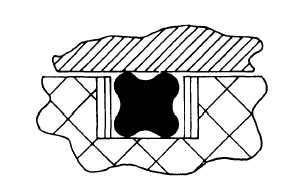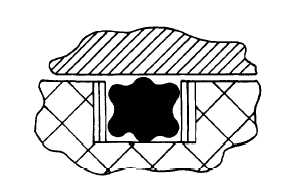spiral. Figure 7-15, view A, shows how to change
the direction of the spiral. The ring is then
stretched slightly, as shown in view B prior to
installation into the groove. While the TFE ring
is being inserted into the groove, rotate the
component in a clockwise direction. This will tend
to expand the ring diameter and reduce the
possibility of damaging the ring.
When TFE spiral rings are being installed in
external grooves, the ring should have a left-hand
spiral. As the ring is being inserted into the
groove, rotate the component in a clockwise
direction. This action will tend to contract the ring
diameter and reduce the possibility of damaging
the ring.
In applications where a leather backup ring
is called for, place the smooth-grained side of the
leather next to the ring. Do not cut leather backup
rings. Use a leather backup ring as one continuous
ring and lubricate the ring prior to installing it,
particularly the smaller sizes. If stretching is
necessary for proper installation, soak the backup
ring in the system fluid or in an acceptable
lubricant at room temperature for at least 30
minutes.
or two backup rings, depending upon the specific
seal groove application and width. The Quad-
Ring® seal works well in, both hydraulic and
pneumatic systems.
Many Quad-Ring® seal sizes have been
assigned NSNs and are stocked in the Federal
Supply System. Quad-Ring® seals in manu-
facturer’s sizes designated as Q1 through Q88 are
interchangeable with O-rings conforming to
AN6227. Likewise, Quad-Ring® seals in com-
mercial sizes Q101 through Q152 are inter-
changeable with O-rings conforming to AN6230
in the respective dash sizes from –1 through–52.
Therefore, the Quad-Ring® seal stock part
number uses the AN standard O-ring designations
AN6227 and AN6230 and the commercial Q dash
number designation. For example, NSNs are
found under such reference part numbers as
AN6227Q10 and AN6230Q103. If the letter Q
does not follow AN6227 or AN6230, the part
number is an O-ring not a Quad-Ring® seal.
If Quad-Ring® seals are not available for
maintenance actions, appropriate sized O-rings
can be installed and they work satisfactorily.
QUAD-O-DYN® SEALS
QUAD-RINGS
The Quad-Ring® seal is a special configura-
tion ring packing, manufactured by the Minnesota
Rubber. As opposed to an O-ring, a Quad-
Ring® seal has a more square cross-sectional
shape with rounded corners (fig. 7-16). The Quad-
Ring® seal design offers more stability than the
O-ring design and practically eliminates the
spiraling or twisting that is sometimes encountered
with the O-ring.
Quad-Rings® seals are completely inter-
changeable with O-rings in the sizes offered by
the manufacturer. They may be installed with one
The Quad-O-Dyn®, also manufactured by
Minnesota Rubber, is a special form of the
Quad-Ring. The Quad-O-Dyn differs from the
Quad-Ring in configuration (fig. 7-17), is harder,
is subject to greater squeeze, and is made of a
different material. The Quad-O-Dyn® seal also
works well in O-rings glands.
The Quad-O-Dyn® is used in relatively few
applications. However, for difficult dynamic
sealing applications, the Quad-O-Dyn® can
perform better than the Quad-Ring. Quad-O-
Dyn® rings are installed in submarine hydraulic
systems plant accumulators.
Figure 7-16.—Quad-Ring.
7-15
Figure 7-17.—Quad-O-Dyn® seal.




